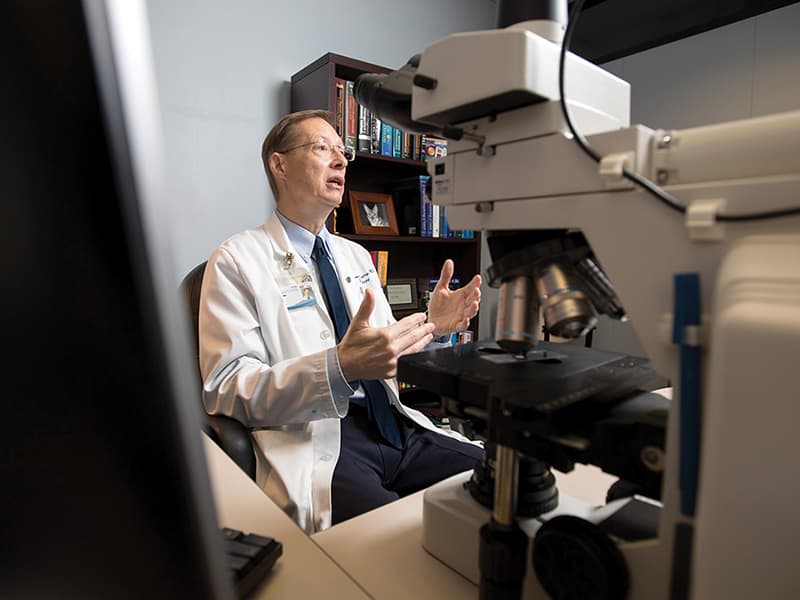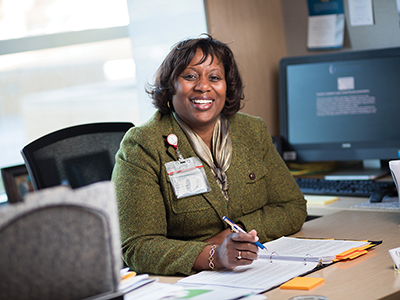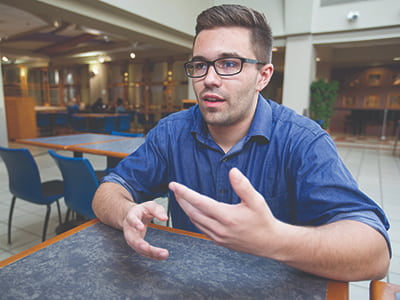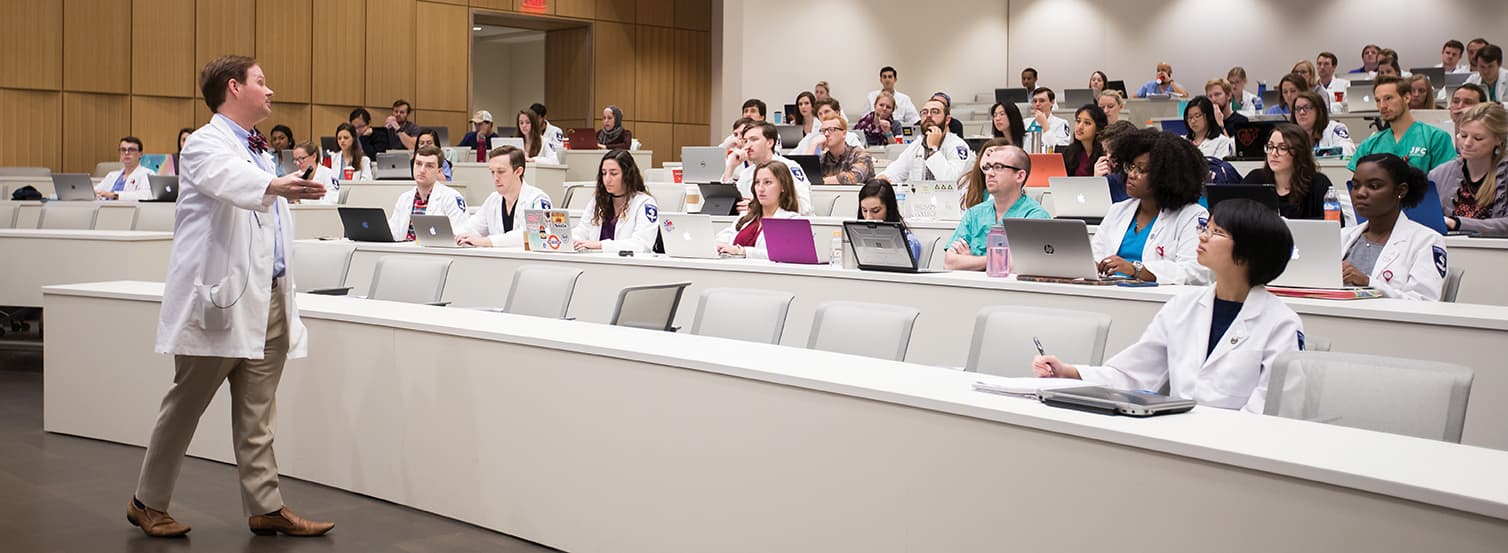U-turn at the lectern
(Top photo: Dr. David Norris, associate professor of family medicine, gestures during a relatively well-attended lecture in one of the School of Medicine's 200-seat amphitheaters shortly after the new building opened.)
NOTE: This article originally appeared in the Winter 2018 issue of Mississippi Medicine, the semi-annual alumni magazine for the School of Medicine.
This professor walks into a room … and no one’s there. No students poised to take notes, no sounds of classroom bustle beyond the ghostly echoes of lectures past. End of joke.
But it’s no joke to Dr. William Daley; it’s serious speculation about the future of medical education, and an ironic one, seeing how he’s considered one of the best teachers and lecturers in the School of Medicine.

The UMMC professor of pathology, who said, “the blood drained from my head” (in a good way) when he was honored for his pedagogic chops as the 2017 Regions TEACH Prize winner in May, has seen more and more students sapped from the lecture hall, a consequence, in part, of a trend known as “No Sage on the Stage.”
“The question of lectures is controversial,” Daley said. “One complaint you hear from some students is, ‘I can’t learn that way.’ And sometimes I wonder how they got to this place in life.”
Lecturing’s place in life is also a question mark; under the umbrella of “active engagement,” innovations such as podcasts, peer-to-peer teaching, inverted classrooms and team-based learning have caused students as well as educators to wonder if,

It should
To paraphrase Jackson-Williams very loosely: If teaching approaches were fire hoses, then lecturing would have the largest nozzle.
“There are times when students should work in a smaller group,” she said. “And there are times when students need to receive a foundation of information to make sure they are on the same path – you can’t do that with a small group.
“Medical students have a very large body of material to absorb in a limited amount of time; for that, the lecture is very effective.”
Active learning is entrenched, though, if for no other reason than validation like this: Test scores rose about six percent for students in active learning settings, while those in lecture classes, by comparison, were about 1.5 times more likely to fail, as reported in a study published in 2014 by the Proceedings of the National Academy of Sciences.
Sara Bolen Parker, for one, looks beyond the numbers. The firehose of lecturing can also spout comfort and kinship to the discomfited and unmoored, said Parker of Madison, an M1.
“I don’t believe lecturing can be easily replaced, especially for the M1 year. Medical school is different from any educational experience you’ve had before. You need to feel like you have company, you need to be with your classmates.
“There’s an important difference between that and sitting at home studying in your pajamas.”
THE DIE IS PODCAST
It’s the podcast – the digital audio file downloadable from the Internet – that has put some students into their PJs, or at least out of the lecture hall.
It is one of the enablers of an active-learning strain, the “flipped classroom,” which is described this way by Wendell Douglas, instructional designer in the Office of Medical Education at UMMC: “It’s when
“The videos are then dissected and discussed in a classroom and/or small group setting.”
Today’s students can choose to soak up lectures either online or live, said Dr. Alison Whelan, chief medical education officer for the Association of American Medical Colleges.
“Either choice reflects a student’s learning style. Medical schools are doing a much better job of tailoring their teaching methods to the way students learn and to the information they need to master.”
By tapping into podcasts, students may hear a lecture multiple times,” said Dr. Sajani “Jeni” Tipnis, associate professor of pediatrics and assistant dean of the School of Medicine.
“So, even when they don’t attend lectures in person, they’re going to class. In a sense, they’re going to class more than ever.”
Still, the original intent of lecture podcasts was to help students review, Jackson-Williams said. “Podcasts were never meant to replace [classroom] lectures.
“If it’s only about the information, then the podcast would suffice. But a lecture enables you to engage with the expert.
“You can’t engage with something that has already occurred, which is what a podcast is. Education is supposed to make you thoughtful, make you consider what is not in front of you. To make you feel challenged about what you’ve just been a part of.
“But some students will default to what’s easier to do. That’s human nature.”
For physicians who have been out of medical school a certain number of years, the idea of chronic lecture skipping may sound like a self-defeating study plan.
For them, an EF Hutton style of learning prevailed: When a professor talked, students listened. In the old-school lecture hall, other than scribbling down notes, that was about all they did. There were no second-chance lectures; there was little or no engagement with the expert.
Even as recently as 1998, the year Daley graduated from medical school here, students were bound by an 80 percent attendance rule; instructors took roll.
Break that rule, Daley said, “and you failed.” That standard began to evaporate about 12 years ago, he said, as did attendance at lectures.
“It was sort of devastating to me the first few years,” Daley said. “Then I decided I’m OK with students getting the material through podcasts.
“I liken it to being a TV preacher. I have my congregation in my church and my congregation at home.”

podcasts come in handy."
During his M1 year, Graham Husband of Meridian was a faithful congregant. “I went to almost all of my lectures,” he said.
Now, he and his fellow M2s have back-slid, he said. “But that’s partly due to the number of activities expected of us; they can conflict with lecture schedules. When you have to miss one, podcasts come in handy.
“But eliminating lectures is not something I’m sure I would want. The best lecturers I’ve heard here have done such a good job teaching, they made me want to dive in and learn more.”
Attendance at many lectures is not required, though; that passive mode of enlightenment is being overtaken by mandatory sessions of active learning, which Dr. David Norris defines as “any activity where the learners have to do more than sit and take notes or read.
“They engage with each other, in small group discussions,
To a civilian observing, say, a small group huddle for the first time, it may seem that medical education’s features have undergone a face transplant.
SMALL GROUPS, BIG QUESTIONS
Inside the
The principal edifier is not Norris, the family medicine professor, but Marlee Wadsworth, another M3. Occasionally, Norris jumps in to elaborate, as he will with a subsequent presentation by Taylor Harvey, the day’s M3 expert on contraception.
Another nine students are monitoring the session from distant locations; their faces pop in and out of a wall-mounted video screen. They do not appear to be wearing pajamas.
This student-led session is just one example of a pervasive element in the modern medical school milieu. It is based on the revelation that, in Douglas’ words, “if you’re just talking, you aren’t teaching.
“Teaching means engaging, with a compelling process to move students toward a deeper knowledge, which is more than they can receive in a 50-minute lecture.
“Teaching has to go deeper than just delivering words.”
Asked if there’s still a place for the lecture in the School of Medicine, Norris said, “absolutely. But, because we as faculty are used to it, it can become our default method, our go-to.”
The challenge is to recognize when other methods work better for the lesson at hand, Norris said.
“Students prefer to actively engage in the material. It’s not boring for them. If you show them how to use the material you’ve presented, that it will be practical for them when they’re physicians, there is a sense of urgency about it.”
It’s not about the pursuit of knowledge, Jackson-Williams said. “It’s about applying that knowledge. That is the clinician’s goal.”
Actually, a kind of eyes-on-the-prize incentive has always been a fixture in medical school training for M1s. The place: the Gross Anatomy Lab, where the dissection of cadavers by tablesful of students is a classic example of practical, hands-on learning.
Small group learning, at that. But that was an exception
“We were beginning to see shifts in education that we see more of now, but there wasn’t a lot of hands-on until the third year, which is typical,” Norris said.
In his day, the counterpart of podcasting was the note-taking service. But it, like podcasts, he said, “just can’t replace being there.”
On a late fall day, for Daley’s presentation, “Laboratory Evaluation of Liver Status,” 18 students decided to be there.
“Attendance varies from class to class,” Daley said. “But you tend to see the same faces.”
Some 182 seats were unoccupied in this setting: one of the twin, 200-seat amphitheaters accommodating lectures in the new School of Medicine education building, which had opened two months earlier.
This raises an existential question about the large lecture hall: In this age of active, small-team
And, if not, why build it?

POWER POINTLESS
For his kidney lecture, Daley stirs his students with his opening line: “‘I’m going to tell you a story about my honeymoon.’”
Daley’s honeymoon tale involves lengthy strolls around London and a nasty bout of rhabdomyolysis. You had to have been there.
The professor tries to put his students there. “I like to use personal anecdotes and humor to make them feel comfortable,” Daley said. “Students complain about professors who just read off the PowerPoint, and I don’t blame them.”
On that note: Norris, for his part, completed his M.A. in higher education last summer; it took 2 ½ years to finish the online course. Why did he do it?
“Medical school prepares you to be a physician,” Norris said. “It doesn’t prepare you to be a teacher.” Among other things, it exposed him to new ways to promote active learning.
And he, like other faculty members, even wield active learning within the lecture framework, temporarily dividing attendees into small groups, for instance, or using the “clicker” to get their instant feedback.
And that’s one reason why the 200-seat theaters
“It was never all about lectures. It is also about a venue for team-based learning – chairs can turn around so students can face each other. The podium can be moved.
“It’s about bringing in panels of experts or patients for the students. It’s about a space where you can comfortably gather a large group of people. So, yes, that space will be used.”
No one interviewed for this article doubts that. And no one advocated for either a no-lecture or an all-lecture curriculum, including Daley, who praised active learning’s assets, or Parker, the M1.
“Small groups keep you engaged,” Parker said. “When
The answer lies somewhere between the two extremes, Douglas said. “The lecturer is the facilitator, connecting the dots, from what the students know to what they need to know.”
Even so, some leading medical schools, particularly those at the University of Vermont and one of two at Case Western Reserve University, have virtually dust-binned lecturing.
Just as “the talkies” and broadcast radio killed the vaudeville stage, it’s possible that new technologies, trends
“Lectures have decreased, but remain a core part of medical schools,” she said. “I believe they will continue to adapt and evolve.”
If lectures disappear, Daley said, he expects the process will be long-winded. “Changing curriculum is a tremendous amount of work.”
Meanwhile, the work of the lecturer remains vital, he said, and, to be effective, it should be the work of someone who demonstrates enthusiasm and “fire.”
“I tell my faculty, ‘Even if there is just one medical student there, give it your best.’”


